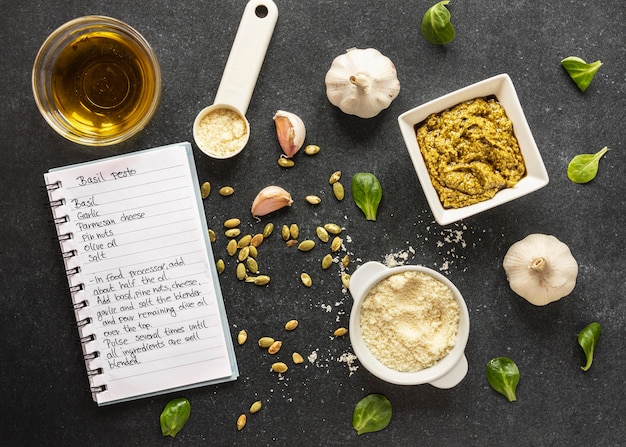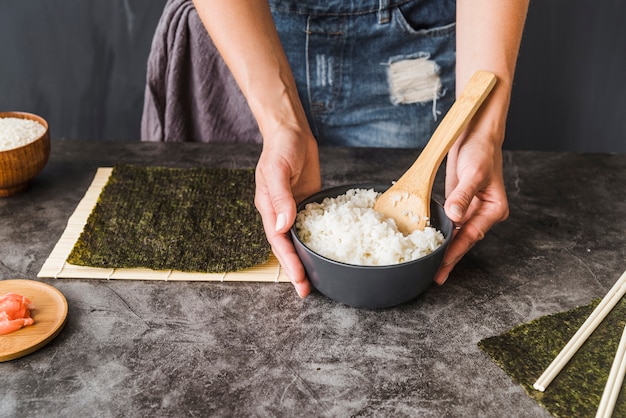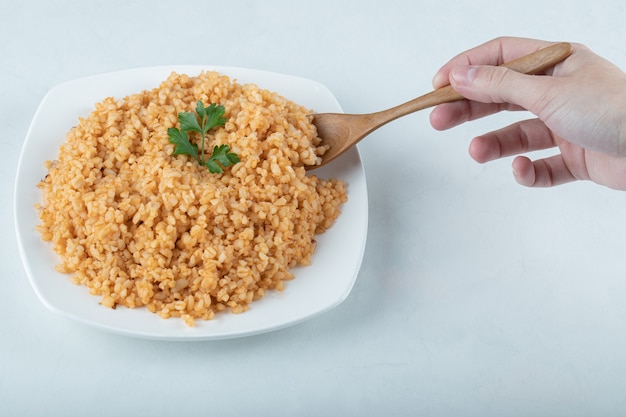Orzo. Just the name conjures up images of sunny Italian kitchens and vibrant salads, doesn't it? It's a pasta that holds a special place in my heart, ever since my Mum used to make this incredible tomato-ey orzo dish with a mountain of fresh basil. It was a summer staple, the smell of it taking me right back to those carefree days. But, you know, even with all that love for orzo, I've met so many people who struggle with cooking it properly. It's not rocket science, but there are some sneaky little tips and tricks to getting that perfect texture, which is key to unlocking its full potential. So, if you're ready to become an orzo master, grab your apron, and let's dive in!
(Part 1) The Basics of Orzo

A Bite-Sized History
Let's start with the basics. Orzo, for the uninitiated, is a small, oval-shaped pasta that belongs to the family of Italian rice-shaped pasta. It's a versatile little guy, a blank canvas for your culinary creativity. You'll find it popping up in salads, soups, even as a base for risottos – the possibilities are endless!
Orzo: A Family Affair
Did you know orzo comes in different forms? There's regular orzo, the classic, small, oval-shaped pasta you'll find in most shops. Then there's large orzo, a bit bigger and perfect for salads and soups. If you're after a healthier option, whole-wheat orzo brings a nutty flavour to the party. And for those with gluten sensitivities, gluten-free orzo is a fantastic alternative.
Choosing the Right Orzo
Now, choosing the right orzo is like picking the perfect ingredient for your masterpiece. First, think about the dish you're making. If you're whipping up a salad, a smaller orzo might be your best bet, whereas a larger one would be better for a hearty soup or a casserole.
Then, consider your dietary needs. Do you need gluten-free pasta? Or are you looking for the wholesome goodness of whole-wheat? And, remember, the quality of the orzo makes a difference. Look for pasta made with good quality ingredients – you'll taste the difference!
(Part 2) cooking orzo: The Dos and Don'ts

The Golden Rules of Orzo
Cooking orzo is a breeze, but there are a few golden rules to keep in mind. First, use plenty of water. It’s always better to have too much than not enough. Second, salt the water generously! Just like with any other pasta, salting the water is key for flavour. Third, don't overcrowd the pot. Too much orzo in the pot and it won't cook evenly. Fourth, stir it up! Stirring occasionally prevents your orzo from sticking together. And finally, don't overcook! Overcooked orzo becomes mushy, so watch out for that.
Avoid These Cooking Pitfalls
Here are a few common orzo cooking mistakes to avoid:
- Undercooked orzo: A cardinal sin! Undercooked orzo will be firm and chewy, not the delightful al dente texture we’re aiming for.
- Overcooked orzo: The opposite end of the spectrum, overcooked orzo turns mushy and loses its shape. Not a good look.
- Not rinsing the orzo: Rinsing the orzo is key. It prevents it from sticking together and removes excess starch, which can make your sauce less creamy.
(Part 3) Mastering the Art of Cooking Orzo

A Step-by-Step Guide to Perfect Orzo
Ready to cook some amazing orzo? Here's a step-by-step guide to make sure your orzo is cooked to perfection:
- Bring a large pot of salted water to a rolling boil: Use about 6 quarts of water for every pound of orzo, and add about 1 tablespoon of salt.
- Add the orzo to the boiling water: Gently stir the pasta to prevent it from sticking.
- Cook the orzo for 8-10 minutes: Orzo is typically ready when it’s cooked al dente – slightly firm to the bite.
- Drain the orzo: Use a colander to drain the orzo, and rinse it with cold water. This stops the cooking process and keeps the orzo from sticking together.
- Use the orzo in your favourite recipe: Time to get creative! Orzo is perfect in salads, soups, casseroles, and more!
Tips for Orzo Excellence
Here are a few extra tips to make sure your orzo is absolutely perfect:
- Don't overcrowd the pot: If you add too much orzo, it won't cook evenly. Cook in batches if you're making a large quantity.
- Use a timer: This helps keep track of the cooking time, ensuring that orzo is cooked just right.
- Taste test: When the orzo is about 8 minutes into cooking, taste a piece to check for doneness.
- Don't overcook: Once the orzo is al dente, immediately drain it and rinse with cold water.
(Part 4) Beyond the Basics: Exploring orzo dishes
Orzo: A Culinary Chameleon
Orzo is a culinary chameleon, effortlessly adapting to countless flavours and cuisines. Let's explore some of the exciting ways you can use this versatile pasta.
orzo salad Inspiration
Orzo salads are a summer favourite. The pasta holds up beautifully to the dressing and adds a delightful texture. Here are a few ideas to get those creative juices flowing:
- Greek Orzo Salad: A symphony of fresh Mediterranean flavours, featuring tomatoes, cucumbers, olives, feta cheese, and a tangy lemon-oregano dressing.
- Caprese Orzo Salad: Simple yet elegant, with juicy tomatoes, fresh mozzarella, basil, and a balsamic vinaigrette.
- Asian-inspired Orzo Salad: A burst of Asian flavours, with edamame beans, carrots, sesame seeds, and a light soy-ginger dressing.
- Summery Orzo Salad: Perfect for warm weather, with fresh corn, bell peppers, red onion, and a light vinaigrette.
orzo soup Delights
Orzo is also fantastic in soups, adding texture and absorbing the delicious flavours of the broth. Here are a few orzo soup ideas to warm you up:
- Chicken Orzo Soup: A classic comfort food, with chicken broth, shredded chicken, carrots, celery, and orzo.
- Tomato Orzo Soup: Light and refreshing, with tomato broth, tomatoes, garlic, and orzo.
- Vegetable Orzo Soup: A healthy and vibrant soup, with vegetable broth, a variety of chopped vegetables, and orzo.
- Creamy Mushroom Orzo Soup: Rich and decadent, with cream, mushrooms, garlic, and orzo.
(Part 5) Orzo: Beyond Salads and Soups
Orzo for Special Occasions
Orzo isn't just for casual meals. It can be a star player for special occasions, too!
- orzo risotto: Orzo can be used as a substitute for arborio rice in risotto. It cooks up quickly and has a beautiful creamy texture, perfect for a fancy dinner party.
- orzo casserole: Orzo is a fantastic base for casseroles. Think creamy cheesy orzo bakes, loaded with vegetables and protein.
- Orzo stuffed peppers: Use orzo as a filling for stuffed peppers for a more interesting and flavorful twist.
Orzo with a Twist: Experimenting with Flavours
Don't be afraid to get adventurous with orzo! Experiment with different flavours and ingredients. Here are a few ideas to inspire you:
- Spicy Orzo: Add some chili flakes for a kick of heat.
- Herby Orzo: Use fresh herbs like basil, parsley, or oregano for flavour and freshness.
- Citrusy Orzo: Add some lemon zest or orange zest for a bright and tangy flavour.
- Cheesy Orzo: Add some Parmesan cheese or ricotta cheese for a creamy and indulgent flavour.
(Part 6) Serving Orzo: A Feast for the Eyes
Presentation is Everything
Presentation is key, especially when it comes to food. Orzo, with its cute little shape, deserves to be showcased!
Serving Orzo in Style
Here are a few ideas to make your orzo dish a feast for the eyes:
- Use a beautiful bowl: A simple white bowl will make your orzo pop, while a colourful bowl will add a touch of whimsy.
- Garnish with fresh herbs: A sprig of parsley, basil, or mint will add a touch of freshness and elegance.
- Sprinkle with grated cheese: A sprinkle of Parmesan or pecorino cheese adds a salty, nutty flavour and a beautiful visual appeal.
- Add a drizzle of olive oil: A drizzle of olive oil adds richness and shine to your orzo dish.
Table Setting Tips
For an extra special touch, pay attention to your table setting when serving orzo. Here are a few tips:
- Use a tablecloth: A tablecloth dresses up your table and creates a more formal look.
- Use napkins: Napkins add a touch of elegance and help keep your guests' hands clean.
- Use silverware: Using silverware shows that you're putting extra effort into your meal.
- Add a centerpiece: A centerpiece will make your table more inviting and give your orzo dish a sense of occasion.
(Part 7) Orzo: A culinary journey Through Time
The History of Orzo
Orzo has a rich and fascinating history. While its exact origins are a bit hazy, it's believed to have been a staple in Italian cuisine for centuries. The name "orzo" comes from the Italian word for barley, and it's thought that the pasta's shape was inspired by barley grains since orzo was originally made with barley flour.
Orzo Around the World
Orzo has travelled beyond Italy's borders, gaining popularity in many other cultures.
- Greece: Orzo is a popular ingredient in Greek cuisine, often used in salads and soups.
- Turkey: Orzo is known as "arpa ??ehriye" in Turkey and is a staple in Turkish cuisine, used in a variety of dishes like soups, stews, and desserts.
- Middle East: Orzo is also popular in the Middle East, where it’s often used in soups, stews, and rice dishes.
The Evolution of Orzo
Today, orzo is more popular than ever. It's enjoyed in countless variations around the world, from traditional Italian recipes to modern fusion dishes. It's a testament to its adaptability and enduring appeal.
(Part 8) FAQs about Orzo
Frequently Asked Questions
You've got questions, I've got answers. Here are some of the most frequently asked questions about orzo:
1. Can I use orzo in place of rice?
Absolutely! Orzo can be a great substitute for rice in many dishes. It cooks up quickly and has a similar texture to rice, but it absorbs the flavours of your dish more effectively.
2. How long does orzo last?
Uncooked orzo can last for several months in an airtight container at room temperature. Once cooked, orzo can be stored in the refrigerator for up to 3-4 days.
3. Can I freeze orzo?
Yes, you can freeze cooked orzo! To freeze orzo, simply spread it out in a single layer on a baking sheet and freeze until solid. Then, transfer the frozen orzo to an airtight container or freezer bag and store for up to 3 months. When ready to use, thaw the frozen orzo in the refrigerator overnight or by microwaving it for a few minutes.
4. What are some healthy toppings for orzo?
Orzo can be a healthy and delicious meal! For a healthy topping, try adding some roasted vegetables, grilled chicken or fish, or a light vinaigrette. You can also sprinkle some nuts, seeds, or fresh herbs for added flavour and texture.
5. What’s the best way to reheat orzo?
The best way to reheat orzo is by adding it to a pan with a little bit of water or broth and heating it over medium heat until it’s warmed through. You can also reheat orzo in the microwave, but it may become slightly mushy.
(Part 9) Orzo: A Personal Reflection
Cooking has always been a source of joy and creativity for me. Orzo, with its simplicity and versatility, has always been a staple in my kitchen. Whether it's a comforting bowl of orzo soup on a chilly day or a vibrant orzo salad on a summer night, it's a reminder of the simple pleasures of cooking and sharing a delicious meal. It's a testament to the fact that sometimes, the simplest ingredients can make the most satisfying dishes.
So go ahead, get creative with orzo. It's more than just pasta—it's a culinary adventure waiting to be explored. Happy cooking!
Everyone is watching

How to Cook Frozen Lobster Tails Perfectly: A Step-by-Step Guide
RecipesLobster. Just the word conjures up images of lavish meals, special occasions, and a taste of luxury. But let's...

Pigs in a Blanket Cooking Time: How Long to Bake for Perfect Results
RecipesAh, pigs in a blanket. Just the name conjures up images of those delightful little parcels of crispy pastry en...

Pork Fillet Cooking Time: How Long to Cook It Perfectly
RecipesPork fillet, or tenderloin as it's sometimes called, is a real favourite in our house. It's so versatile, and...

The Ultimate Guide to Cooking Delicious Frankfurters
RecipesLet's face it, we all love a good frankfurter. It's a classic, simple, and always satisfying. But let's be rea...

Wolf Meat Recipes: A Guide to Cooking Wild Game
RecipesLet's be honest, you don't see wolf meat at your local butcher shop every day. It's a bit of a wild card, but ...
